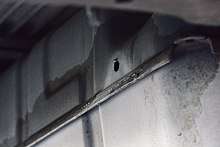Gasoline theft
Gasoline theft occurs when gasoline is stolen from a gas station, pipeline or vehicle.

From vehicle tanks
The rate of fuel theft is accelerating as fuel prices climb, which makes more employees tempted to steal fuel. Employees can siphon fuel from fuel tanks or use special devices to make it difficult to detect that fuel is gradually leaving the fuel tank. That employee-related crime now costs the United States trucking industry $2.1 billion a year.[1]
Vehicle tracking systems are used by some companies to monitor cases of fuel theft and to raise effectiveness of fleet usage.
From filling stations
Gasoline theft (sometimes known colloquially as fill and fly, gas and dash, and drive-off) is the removal of gasoline from a station without payment. The thief will usually use some form of decoy to prevent nearby witnesses from noticing the lack of payment until they have left the station. Common decoys include pretending to press the wrong buttons after the credit card are swiped or having multiple people get gas at the same time, with one paying for another person and the other running off with both cars.
With typical gas thefts costing station owners in the range of $50 per incident, many stores have fought back by installing better video equipment and requiring prepayment.
Since the oil price increases after 2004, a surge in fuel theft has occurred, which has included license plate thefts (when gasoline is stolen with the vehicle having the original tags and the vehicle tags identifying the registered owner).
From pipelines
Oil and gasoline are stolen by illegal taps in petroleum pipelines, and billions of dollars worth of product are stolen annually. Targets are the petroleum industry in Nigeria, the Nembe Creek Trunk Line, the Ceyhan-Kırıkkale Oil Pipeline, and the petroleum industry in Mexico.
Organized crime and local people are involved.[2]
Illegal taps have caused leaks and explosions such as the following:
- 2006 Abule Egba pipeline explosion
- 2006 Atlas Creek pipeline explosion
- 2019 Tlahuelilpan pipeline explosion
See also
- 2010 South Kivu tank truck explosion